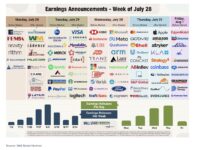 By Greg Naylor
By Greg Naylor
January was an eventful month, as the federal government extended most of the Bush tax cuts and delayed sequestration for two months. In addition, data shows that the flows of money from stocks to bonds have reversed for the first time in several years. Here is a re-cap of January by the numbers:
Stocks & Bonds
Global stocks started the year strongly. Bonds posted back-to-back losses as money flowed from fixed income to equities. Whether or not this is the beginning of a trend or just a blip remains to be seen. Inflation remains tame and below Federal Reserve targets.
| S&P 500 Total Return | MSCI EAFE | BarclaysAggregateBond | Unadjusted CPI | |
| January | 5.18% | 5.18% | -0.70% | -0.27% |
| December | 0.91% | 3.11% | -0.14% | -0.47% |
| YTD 2013 | 5.18% | 5.18% | -0.70% | -0.27% |
Commodities & Currencies
NYMEX crude gained 6.3% in January to close at $97.65 per barrel. Most other commodities also posted gains for the month. Gold, however, slipped 0.9%.
The dollar index jumped 3.2% in January. Japan’s newest prime minister has pressed for a weak yen to boost exports, joining the ranks of global political leaders who hope to battle the global recession through currency depreciation. America’s official ‘strong dollar’ policy remains something of an exception.
Economy
Economic indicators offered some good news in January. The Institute for Supply Management reported that the manufacturing PMI in January rose to 53.1, indicating continued expansion. Although the most recent GDP report indicated a surprise 0.1% contraction in the 4th quarter, recent positive data on the shrinking trade deficit leads some economists to think that this ‘contraction’ was a reporting error and will be re-stated as small growth.
The National Association of Realtors (NAR) reported that the annual rate of existing-home sales in December declined by 1.0%, although for the year sales volume was up over 9%. National median prices rose in December by 10.9% to $180,300. Some experts believe that the housing market overcorrected during the downturn. And of course, historically low interest rates are a tremendous boon to the housing market.
Summary
Markets will probably remain on pins and needles this year as Obama and Congress continue to spar. I increasingly hear questions about whether or not we are in a stock ‘bubble.’ If you look at the remarkable gains of the last few years, it might seem so. However, perspective is everything. Major indices are just now returning to their 2007 levels, yet corporate profits are even higher today than they were 6 years ago. I am always concerned about the possibility of a downturn, but in my opinion the data do not indicate ‘bubble’ conditions in the stock market. We are actually more concerned about the possibility of inflated prices in the bond market.
This material was prepared by Greg Naylor, and does not necessarily represent the views of Woodbury Financial or its affiliates. This information should not be construed as investment, tax or legal advice and may not be relied upon for the purpose of avoiding any Federal tax liability. This is not a solicitation or recommendation to purchase or sell any investment or insurance product or service, and should not be relied upon as such. The S&P500, MSCI EAFE and Barclays Aggregate Bond Index are indexes. It is not possible to invest directly in an index.
Investing involves risks and investors may incur a profit or a loss. Past performance is not an indication of future results.
Data Sources:
www.standardandpoors.com – S&P 500 information
www.msci.com – MSCI EAFE information
www.barcap.com – Barclays Aggregate Bond information
www.cmegroup.com – NYMEX crude prices
www.bloomberg.com – U.S. Dollar & commodities performance
www.realtor.org – Housing market data
www.bea.gov – GDP numbers
www.bls.gov – CPI and unemployment numbers
www.commerce.gov – Consumer spending data
www.napm.org – PMI numbers
www.coinnews.net – Gold and silver price information
About Greg Naylor: Greg is a partner and co-founder of Fiat Wealth Management, an independent financial advisory firm in Long Lake, Minnesota. He has been investing for over 7 years and enjoys sports, reading, singing, and spending time with family. Greg is a 2004 graduate of the University of Minnesota and lives in South Minneapolis with his wife Kat. Click here for more articles by Greg.
Twitter: @seeitmarket Facebook: See It Market








